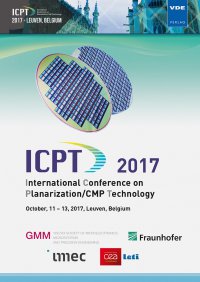Effect of Deposition Methods on Material Removal Rate During Nickel CMP
Conference: ICPT 2017 - International Conference on Planarization/CMP Technology
10/11/2017 - 10/13/2017 at Leuven, Belgium
Proceedings: ICPT 2017
Pages: 6Language: englishTyp: PDF
Personal VDE Members are entitled to a 10% discount on this title
Authors:
Wang, Yanni (imec, Kapeldreef 75, 3001 Heverlee, Belgium & Clarkson University, 8 Clarkson AVE., Potsdam, New York 13699, USA)
Teugels, Lieve; Vandersmissen, Kevin; De Gendt, Stefan; Struyf, Herbert (imec, Kapeldreef 75, 3001 Heverlee, Belgium)
Krishnan, Sitaraman (Clarkson University, 8 Clarkson AVE., Potsdam, New York 13699, USA)
Abstract:
Nickel is being considered as an alternative metal in interconnects and is a potential candidate as micro-bump material in 3D applications. Depending on the application, different nickel deposition methods may be chosen to achieve the required material properties or filling dimensions. Chemical mechanical planarization (CMP) steps will be needed to integrate nickel into an advanced device flow. In this work, nickel films prepared using three different deposition methods, namely, physical vapour deposition (PVD), electroplating, and electroless deposition (ELD), were studied and compared. Material removal rates (MRRs) during CMP of these three types of nickel layers were characterized using well-defined silica-based polishing slurries and resistivity for film thickness measurements. Hydrogen peroxide was used as the oxidizer and glycine as the dissolution promoter (complexing agent). The effects of peroxide and glycine concentrations in the slurry, and the pH of the slurry, on MRRs were studied. X-ray photoelectron spectroscopy (XPS), atomic force microscopy (AFM) and nanoindentation techniques were also used to achieve a better understanding of the polishing behaviour. Keywords: Nickel Films, Chemical Mechanical Planarization, Deposition Methods, Polishing Behaviour, Hydrogen Peroxide, Glycine


